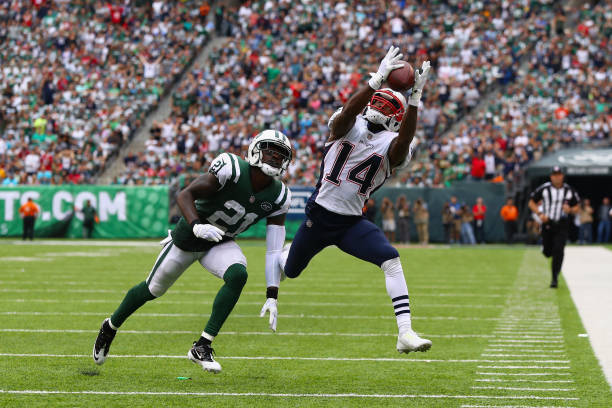Brandin Cooks has not failed to impress as the NFL zeros in closer to the midpoint of the season. He has clocked in 472 receiving yards on 24 receptions and two touchdowns, including a game-winner against Houston, all in six games. Leading the Patriots’ crippled receiving corp, Cooks has held down the role of running routes on the sideline. Before the season began there were comparisons to Cooks and Randy Moss, one of Tom Brady’s all-time best receivers.
Cooks is on pace for a third consecutive 1000+ yard season and is comfortable being a Patriot. But one of his stats so far this season has raised a few eyebrows in confusion. In his three-year stint in New Orleans prior to this season, Cooks has boasted extremely high catch percentages. From 2014-2016, Cooks averaged 7.5 targets per game and caught 69.5% of his targets. In his first six games as a Patriot, he has averaged 6.8 targets, hauling in 58.5% of them.
How Could This Be?
Brandin Cooks is not on a decline surely enough, he is the same receiver that he was in New Orleans. But how could he catch targets more often on the Saints? The answer could lie within the routes Cooks has ran for the Saints compared to the Patriots. He has solely ran deeper routes across the sideline for the Patriots, but did similar things for the Saints. If anything, the Patriots have relied on Cooks a little more in the absence of Julian Edelman. At the same time, however, Chris Hogan has shared a similar role to Brandin Cooks in the offensive scheme.
Football and Physics
The answer to this enigma could possibly be the product of pure physics. No two quarterbacks throw at the same velocity and force. Brandin Cooks has had the privilege so far in his career to work alongside Drew Brees and Tom Brady. In an ESPN Sports Science segment years ago, Drew Brees clocked in his throwing speed at 52 miles per hour, or 23.2 meters per second. Tom Brady on average takes 0.39 seconds to get a pass off at an initial velocity of 61 mph, or 27.3 m/s.
https://youtu.be/Kl7ZK3a0TkU
The acceleration of each QB’s passes are found using the equation Δv/t, or the change in velocity over time. Assuming the initial velocity is the same as the final and using 0.39 seconds as the time for each, Brady’s acceleration would be 70.0 m/s² and Brees’s would be 59.5 m/s².
The formula for force is m·a (mass multiplied by acceleration). If the average football mass is about 0.425 kilograms and using the accelerations yielded, Tom Brady would throw with a force of 29.75 N and Drew Brees would throw with 25.29 N.
The Math Doesn’t Lie
Brandin Cooks’s targets from Tom Brady are thrown harder than from his former quarterback Drew Brees. In order to catch a more forceful pass the receiver has to bring his hands in closer to his body to absorb the ball’s momentum. Brandin Cooks has been fairly successful with catching Brady’s passes, but has shown some struggle catching shorter passes. In recent weeks, however, he has shown improvement with his catch percentage. It has fluctuated from around 40% in Week 1 to around 65% in Week 6, and the high was Week 3 at around 70%. The Archer is slowly acclimating to a new quarterback, and will be in mid-season form in no time.

